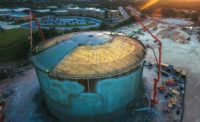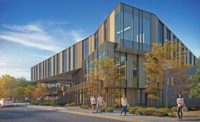Builders working across the Southeast are continuing to experience robust contracting opportunities in a broad range of markets, with most project sectors showing steady growth. More than a year into the new presidential administration, some Southeast contractors are starting to see impacts from a “Trump effect” related to reduced corporate taxes and trade policies. But that effect appears to be building on top of market fundamentals that continue to support ongoing construction and development activity across the region.
“Overall, the Southeast is extremely strong in most geographies and most product types,” says Mark Whitson, Southeast regional leader for DPR Construction in Raleigh-Durham. On a state-by-state basis, Whitson noted that metropolitan areas throughout Florida, the Carolinas, Georgia and Tennessee especially stand out in terms of contracting activity.
“Drive around and you’ll notice cranes everywhere with street and lane closures dotting cities’ landscapes,” adds Huntly Gordon, president with Atlanta-based New South Construction. “There was a lot of pent-up demand, and now with the private sector kicking into full gear, our markets are robust.”
Related Link:
ENR Southeast 2017 Top Starts
Health Care Upswing
Despite the ongoing uncertainty related to the Affordable Care Act, health care projects remain a strong source of activity.
“All markets have a heavy health care push,” Whitson says. “Despite the threats to repeal the Affordable Care Act, most of the geographies in the Southeast are moving forward with health care,” with Florida and Georgia standing out for their overall strength.
Gordon also cited the industrial, aviation, mixed-use, multifamily, hospitality and “now office work” markets as among the Southeast’s “main drivers.”
“The health care, hospitality and office sectors are increasing, while multifamily appears to be slowing somewhat,” says Gordon. Additionally, the increased level of development activity—and resulting economic optimism—has “local and state governments preparing and increasing their budgets to keep up with demand to support their communities,” with public-private partnerships likely to become a more popular tool for governmental entities, he says.
Market conditions are also robust in Charlotte, says Megan Asher of Edifice Inc., who currently serves as president-elect for the Charlotte chapter of the Society of Marketing Professional Services (SMPS).
“Across the AEC industry in our region, everyone is working at capacity with a healthy backlog looking into 2019,” she says. “Charlotte’s overall construction market is strong, with momentum building by the day. This is a forecast similar to what we saw last year, but one that doesn’t show any signs of slowing down.”
The apparent “Trump effect” is being felt most prominently in the corporate and manufacturing sectors, says Whitson.
“Corporate tax reform has made a lot of companies take some of that savings and push toward capital investment,” he says, especially within the office and commercial construction markets. With private financing still readily available, “that tax adjustment is allowing those customers a little extra cash to invest in their people and their capital, and refreshing or expanding their facilities.”
Additionally, the Trump administration’s policies on trade—including the placement of potential tariffs on imported items—is spurring activity by foreign companies, Whitson observes.
“Instead of paying significant tariffs on imports, foreign manufacturing companies are pushing to get facilities in place to manufacture in the United States,” he says. Additionally, Whitson notes that some of these manufacturers are seeking to accelerate completion of ongoing construction projects to avoid future penalties.
Facing these robust building markets while also dealing with an ongoing labor shortage is causing an increasing reliance on prefabrication. The trend of providing offsite prefabricated elements to control labor costs and improve schedules is “picking up steam,” says Gordon.
At DPR, Whitson adds, “We’re working to integrate our digital design and virtual design and construction into prefabricated components that we either manufacture or buy from others.”
At the same time, the construction industry’s workforce and price pressures are prompting owners to push for greater cost and budget certainty for projects. And that’s the bottom-line challenge for Southeast contractors today.
Says Gordon: “Regardless of the criteria or expectations, contractors are challenged in all directions, both internally and externally, and they have to be cognizant of this or be left behind.”
About the Ranking
Primary sources for the Top Starts ranking are Dodge Data & Analytics as well as ENR Southeast’s own reporting during the past year and related research. Additionally, ENR Southeast asked contractors and designers to provide information about the largest Southeast contracts their firms started building during 2017.
In all, this year’s Top Starts list ranks 40 projects from across the Southeast region, which includes Alabama, Florida, Georgia, North Carolina, South Carolina, Tennessee and Puerto Rico. Collectively, this year’s ranking reflects nearly $11.7 billion in contracts. We invite you to read on to see all of the projects influencing the Southeast construction economy.






